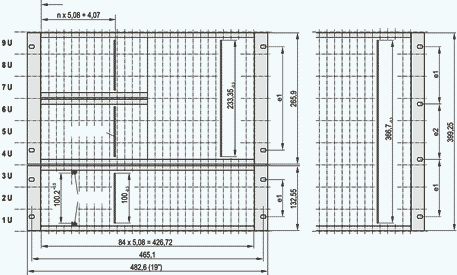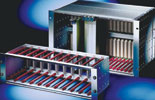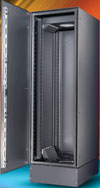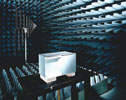
The basis for the mechanical design of nearly all electronics packaging systems is the 19” standard, which is laid down in IEC 60297 and its US counterpart, IEEE1101.x.
These specifications define the interfaces between individual components such as connectors, PCBs, subracks, cases and cabinets, enabling users to obtain compatible system components from a variety of sources.
Created in the mid-1970s, the 19” standard has become established as the most commonly used framework for electronics enclosures. In 2000 a process of adaptation took place between the IEC and IEEE standards, which removed almost all of the remaining minor differences between them. A metric standard, IEC 60917, was defined in 1988, though this has only been adopted in the telecommunications sector.

The IEC 60297 standard specifies the mechanical design and physical dimensions of components, PCBs, subracks and racks/cabinets for 19” systems, with the 19” dimension corresponding to a front panel width of 482,6 mm. Sub-units of width are specified in HP (horizontal pitch), equal to 5,08 mm, and height is given in U (height units) of 44,45 mm.
Cases and subracks
Electronics packaging systems may be realised as subrack/plug-in systems, desktop systems or tower systems. In desktop and tower versions, the element of visual appearance is of greater importance than it is for subrack or chassis-based systems housed in a cabinet or rack.

Internal construction is, however, fundamentally the same for all types. Customers can either select individual mechanical components – such as horizontal rails, side panels, rear panel and EMC accessories – or opt for a ready-made chassis fully preconfigured for a particular application.
The role of the cabinet
The 19” cabinet is mostly used in situations where a variety of electronics packaging is required, eg, for a control system or one that involves a series of measuring or monitoring devices. Closed cabinets not only accommodate the systems but also provide certain protective functions such as EMC shielding and IP protection.

In addition, the cabinet can deal with other environmental influences such as ambient temperatures or dynamic loads, and enables the use of intelligent cabling concepts, cooling systems, access control and power distribution systems.
EMC shielding
The front cover of a system is formed by one or more front panels. As well as making a strong visual impact as the ‘face’ of the system, the front panel is an important element in the provision of electromagnetic shielding.

Since each individual plug-in board in a system normally has its own front panel, relatively long vertical slits occur on the front of the unit between the various panels, which, without suitable shielding, could significantly affect the electromagnetic compatibility of the components inside the system.
For example, in a system with a processor clock frequency of 1 GHz, the electromagnetic wavelength (λ) is approximately 0,3 m. The critical length at which significant electromagnetic interference or radiation occurs is equivalent to λ/10.
In this example, then, the maximum permissible dimension of any slit or gap would be 30 mm. Longer slits must be avoided and any gaps fitted with suitable seals – EMC gaskets in either textile or stainless steel – which provide a conductive link between the various front panels.
Thermal management
The mechanical design of a system, and the shielding provisions in particular, have a direct bearing on the thermal management of an electronics packaging system. A system that is as closed as possible is best in terms of EMC shielding but usually has a negative effect on cooling.
However, the parallel arrangement of the PCBs and the defined vertical airflow thus obtained are such that an optimised air-cooling system based on fans is normally sufficient. For high-performance systems, additional requirements regarding cooling are set out in specifications such as CompactPCI, VMEbus, MicroTCA and AdvancedTCA.
IP ratings
Another key function of an enclosure is to provide protection against the entry of water or foreign bodies such as dust, tools, wires or fingers. The different levels of ‘ingress protection’ (IP) are set out in the IEC 60529 standard.
IP ratings consist of two digits: the first one ranges from 0 to 6 and denotes the level of protection against foreign bodies, whereas the second one ranges from 0 to 8 and denotes the level of protection against water.
Static and dynamic loads
It is important for an enclosure to have a sufficient load-carrying capacity for its intended application or else it may have a tendency to creep – ie, to deform, even under a static load – and this may undermine any EMC and IP measures that have been taken.
Static loads arise primarily from the weight of components contained in a system, and individual specifications such as VME and CompactPCI set out the maximum weight for plug-in boards, so that the total load of a system may be calculated.
If the system is likely to be exposed to dynamic loads, eg, by being situated close to rotating machines or used in railway applications or on ships or aircraft, the design should include suitable protection against shock and vibration, eg, shock absorbers.
Systems destined for regions with high seismic activity must also be tested to what is known as the Bellcore standard for earthquake resistance.
For more information contact Kevin Klaff, Actum Electronics, +27 (0)11 608 3001, [email protected], www.actum.co.za
| Tel: | +27 11 608 3001 |
| Email: | [email protected] |
| www: | www.actum.co.za |
| Articles: | More information and articles about Actum |

© Technews Publishing (Pty) Ltd | All Rights Reserved